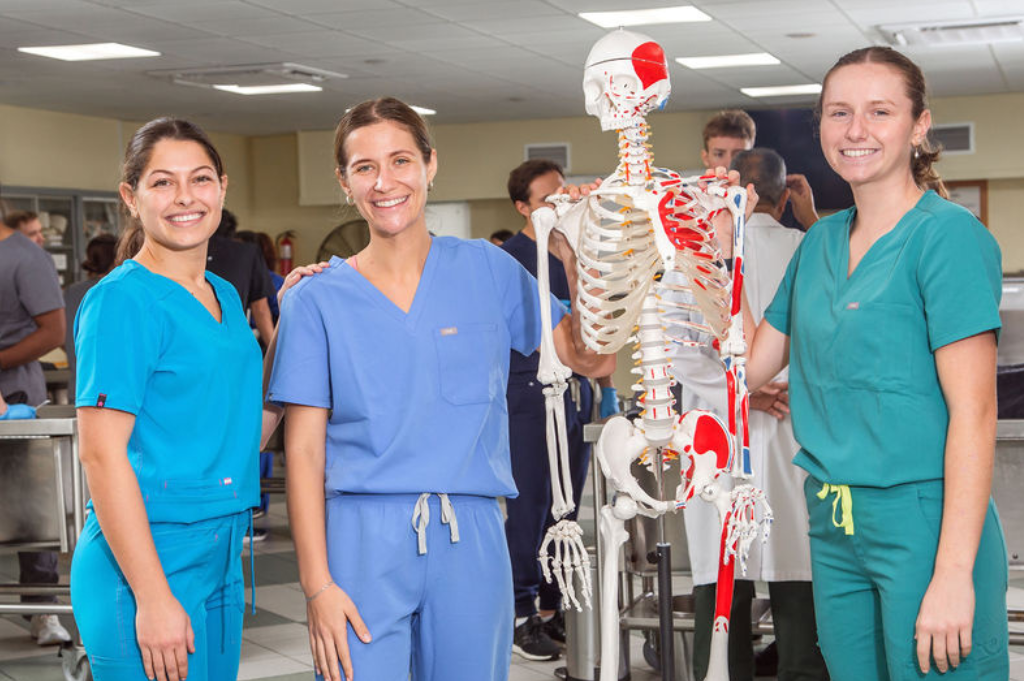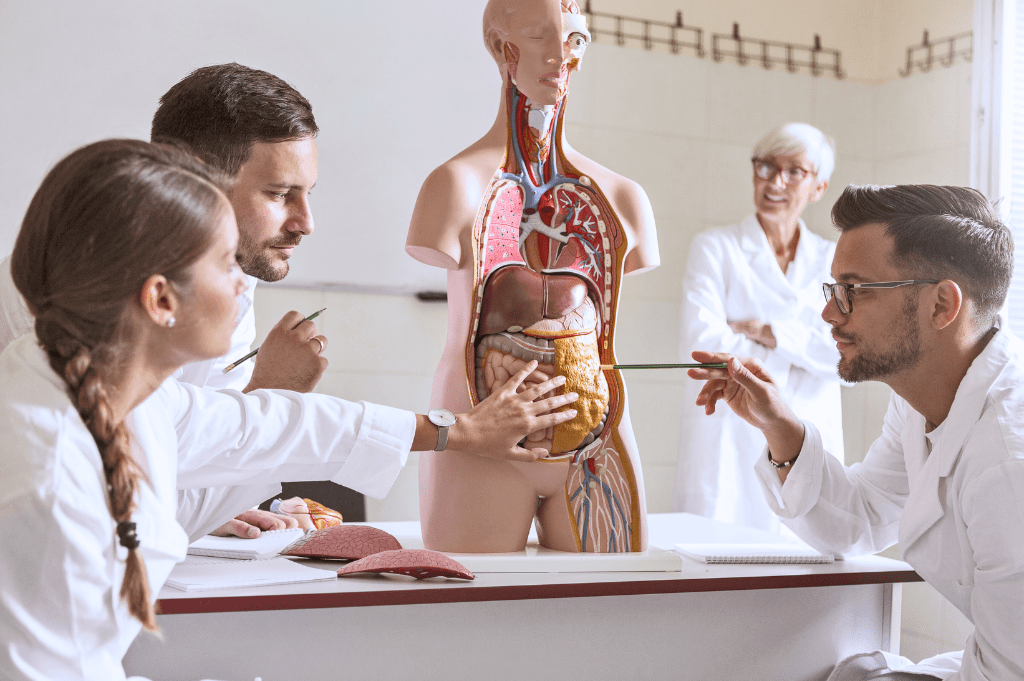
How to Study Anatomy in Medical School: The Ultimate Guide
If you want advice on the best way to study anatomy as a medical student, take a look at this anatomy study guide.
Anatomy is an important part of all medical school programs. Everyone working in the medical and healthcare fields, including doctors, needs to have a good working knowledge of anatomy.
However, anatomy is a huge and complex subject area – from the largest bones to the smallest glands – so medical students benefit from support as they tackle this all-important subject .
In order to provide this help and guidance, we’ve gathered some key information about anatomy that can help your learning efforts. Check it out below!
What Is Anatomy?
So, what is the study of anatomy? Anatomy is the branch of medicine that explores the structures of the human body, from the skeletal framework that supports us to the intricate network of muscles, glands and organs that keep us alive. Understanding these structures is fundamental to practicing medicine.
While advanced imaging technologies allow us to study living anatomy in incredible detail, there is no substitute for hands-on learning. At Saba University School of Medicine (SUSOM), we recognise the value of working with cadavers – providing students with a tangible, three-dimensional understanding of the human body that textbooks and screens simply cannot replicate.
Mastering anatomy is about more than memorising parts; it’s about seeing how they function together as a whole. This knowledge is crucial for diagnosing and treating illnesses, making it one of the most important subjects you’ll study in medical school.
What Are the Branches of Anatomy?
When looking at how to learn anatomy, you’ll first have to know the different things you’ll need to learn. Since anatomy is looking at the structure of a body, there are different branches of anatomy, based on the different ways we can look at the body.
Gross anatomy
Gross anatomy is also called macroscopic anatomy. This refers to anatomical features that are large enough to see with the naked eye, such as skin or bones. Gross anatomy is further split into:
- Surface Anatomy: Everything on the surface of the body.
- Regional Anatomy: The anatomy of a specific area of the body, for example, the head.
- Systemic Anatomy: A specific organ system, for example, the digestive system.
Microscopic anatomy
Microscopic anatomy focuses on anatomy at the tissue level or cellular level, and how cells form larger structures. This type of anatomy is typically studied with tools such as microscopes. Microscopic anatomy is further split into:
- Histology: Tissue, such as connective tissue or muscles.
- Cytology: Cells, including samples from sputum, urine or blood.
Difference Between Anatomy and Physiology
While medical schools often teach them together, physiology is separate from the study of anatomy. Anatomy is the study of the structure of the parts of an organism, such as the human body. Meanwhile, physiology focuses on the way those parts work and function together.
For example, the heart’s anatomy means the heart’s structure, such as its valves, veins, chambers and arteries. The physiology of the heart means how the heart pumps the blood.
Anatomy and physiology are both fundamental fields of biology and relate to the body parts of living beings. While the two fields are different, they both interact together and rely on each other. So, physiology is another thing that medical students have to learn while studying anatomy. It’s complicated considering you can’t learn one without learning the other, and that is why an eagerness to learn is such a key factor that we look for in medical students.



Why Do You Need to Study Anatomy as a Medical Student?
Studying anatomy is important as it lays the foundation for everything else in medicine. You’ll need to know anatomy for performing physical examinations on patients, carrying out procedures, examining test results and discussing cases with patients or other physicians.
Knowing anatomy, along with physiology, lets you determine what help a patient needs – it really is a building block for all medical care. Once you know how to study anatomy in med school, you’ll be able to gain useful knowledge that will take you from classroom learning in Basic Science, to your clinical rotations, and into working as a medical doctor.
How to Study Anatomy Effectively
Anatomy is a subject where there’s a lot to learn, so it’s vital to have a good study plan. Here is our study guide for human anatomy and physiology, which should effectively highlight how to study anatomy in medical school.
Create an anatomy glossary
There are so many names and terms to remember in anatomy – there are hundreds of bones, as well as plenty of organs and other parts of the body, and you need to know what each is called. Try making a glossary to help you remember key terms. You can even color code the glossary to help.
Routine and resources
Establish a non-negotiable study routine for yourself. Study key concepts frequently and often, making sure to set added time aside for more challenging material. Remember, practice makes perfect. You can also use flashcards, mnemonics and diagrams to help make studying and remembering easier.
Study as soon as you can
If you’ve got a test coming up, don’t leave it till the last minute to study. Make sure you revise well in advance and get through any additional reading long before your grades depend on it.
Join or create a study group
It’s always worth asking people in your classes to study together. This can be a great way to go over notes from lectures and cement the knowledge you’ve learned. You can also quiz one another, as well as help each other with things you’re struggling to understand. As an added benefit, study partners often become friends that stick together throughout med school, residency and beyond!
Test your knowledge
Testing yourself is a great way to see where your weak spots are. You can use old exam papers or write your own quizzes – especially if you have a study group to support your efforts – and find out where you need to brush up or expand your knowledge.
Make the most of dissection and anatomy tutorials
Dissections are a great way to learn anatomy. If your school offers dissection sessions, as SUSOM does, you should come prepared. Try to learn a bit about the subject body part before the session and think up any questions you might want to ask. If your school does not offer dissections, you could try to find dissection explanations online.
Break it down into sections
The human body is a massively complex machine, and it would be very hard to learn all about the anatomy of the entire body at once. Instead, break the subject down into sections and link them together later. This can help you learn the smaller details, such as the different chambers and parts of the heart, without getting overwhelmed.
Link anatomy and physiology
One of the easiest ways to remember how something is built is to consider what it has to do. When considering how to study for anatomy and physiology exams, remember to link the two to remember what every part of the body does.
Take detailed notes
Taking detailed notes or having a recording (if approved) of your lectures can help make sure that you get all the details right when you are writing up your revision notes later. Include all the details you think you’ll need.
Learn Anatomy at Saba University School of Medicine
Anatomy might be hard to learn, but this knowledge is invaluable for those developing a future career as a practicing medical doctor.
At Saba University School of Medicine, our Basic Science program on the island of Saba will provide the classroom and lab-based instruction that MD program students need to develop a deep understanding of key medical systems and processes, before they progress into core rotations (in the U.S.) to experience hands-on training with real patients.
To learn about the SUSOM student experience, including the use of cadavers to better understand anatomy, check out this testimonial video from an MD program student:
Then reach out to ask questions or start your own application today!
FAQs About Learning Anatomy
A combination of visual learning, repetition and practical application is the best way to learn anatomy. Interactive tools like cadaver dissections, anatomical atlases and digital 3D models help bring concepts to life. Breaking topics into manageable sections and consistently reviewing material can help you with how to memorize anatomy most effectively.
Anatomy is challenging because of the vast amount of information to learn, but with the right study strategies, it becomes manageable. Consistent practice, hands-on experience and understanding rather than memorising structures make a big difference. Many students find it one of the most rewarding subjects in medical school.
The five basic areas of anatomy are gross anatomy (structures visible to the naked eye), microscopic anatomy (cells and tissues), developmental anatomy (changes from conception to adulthood), neuroanatomy (the nervous system) and comparative anatomy (differences between species). Together, they provide a complete understanding of the human body.
A combination of resources is best, including cadaver dissections, textbooks like Gray’s Anatomy and digital platforms like the Visible Body app. Atlases such as Netter’s Atlas of Human Anatomy offer detailed illustrations, and spaced-repetition flashcards can help with memorisation. Choosing resources that match your learning style will make studying more effective.

For Prospective Students
SUSOM is committed to supporting prospective students throughout the admissions process. Please click the following links for detailed information about each topic: